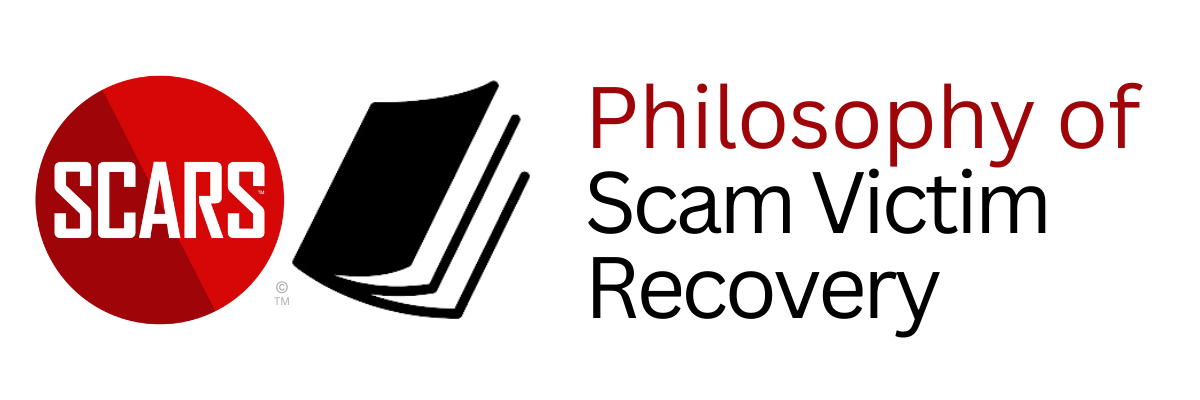The Sword of Damocles Hanging Over Every Scam Victim’s Head
The Sword of Damocles: A Metaphor for Living Under Threat After a Scam for Scam Victims
Primary Category: Scam Victim Recovery Philosophy
Intended Audience: Scam Victims-Survivors / Family & Friends
Author:
• Tim McGuinness, Ph.D., DFin, MCPO, MAnth – Anthropologist, Scientist, Polymath, Director of the Society of Citizens Against Relationship Scams Inc.
About This Article
After being scammed, many survivors live under the emotional weight of what feels like a constant threat—the fear that it could happen again, that others will find out, or that safety is gone forever. This lingering dread is best captured in the ancient parable of the Sword of Damocles: the image of danger hanging silently overhead, rendering joy impossible and security fragile. Scam victims often carry that same invisible sword—though the scam has ended, the emotional tension remains.
But that sword can be named, understood, and ultimately removed. Healing begins with acknowledging fear rather than hiding it, separating past threats from present reality, and gradually rebuilding trust—first in yourself, then in others. With practical tools like mindfulness, daily self-reflection, boundary-setting, and small acts of joy, you can create psychological distance from the trauma.
Reclaiming safety, as the Stoics teach, doesn’t come from eliminating risk, but from strengthening your ability to respond wisely, calmly, and clearly. The Sword of Damocles may have shaped how you once saw the world—but it does not have to define your future. The moment you begin to reclaim your voice, your trust, and your peace, is the moment the sword begins to disappear.

The Sword of Damocles: A Metaphor for Living Under Threat After a Scam for Scam Victims
What was the Sword of Damocles
The Sword of Damocles is a symbolic story from ancient Greek lore that illustrates the constant threat or anxiety that accompanies power, privilege, or perceived security.
The Origin of the Story
The tale comes from the court of Dionysius II, a 4th-century BCE tyrant of Syracuse. According to the Roman philosopher Cicero, Damocles was a court flatterer who envied Dionysius’s wealth and power. He remarked how fortunate Dionysius must be to live in such luxury and authority.
In response, Dionysius offered to switch places for a day so Damocles could taste what it was like to be in his shoes. Damocles eagerly accepted—only to find, during a lavish banquet, that a sharp sword had been hung above the throne by a single strand of horsehair, dangling precariously over his head.
Though surrounded by riches and honor, Damocles was too terrified to enjoy any of it. He quickly begged to leave, realizing that power and status come with constant danger, responsibility, and vulnerability.
Modern Meaning
Today, the “Sword of Damocles” is used metaphorically to describe:
-
-
-
A looming threat or persistent sense of dread
-
The fragile nature of security or happiness
-
The burden that comes with responsibility or success
-
-
For example, a scam victim who lives in fear of their story being discovered—or who feels their financial stability could collapse at any moment—may feel like they’re living under the Sword of Damocles.
It represents the tension between what appears stable on the outside and the invisible risks and pressures that hang just out of sight.
For Scam Victims
In the aftermath of a scam, many victims find themselves unable to relax, trust, or feel safe again—even when the threat is no longer active. It’s not just the loss that haunts them; it’s the fear of what might happen next. The fear of judgment. The fear of financial ruin. The fear that somehow, this will happen again. This sense of unease has a name in classical philosophy: the Sword of Damocles.
The ancient parable isn’t about scams, but its emotional truth mirrors the post-trauma state many scam victims experience. The sword becomes a symbol of constant psychological pressure—one that keeps victims frozen, anxious, and unable to fully move forward.
If you’ve ever felt like your peace of mind is hanging by a thread, this story has something to teach you.
What It Means
For scam victims, the sword is not physical—but it is just as real. After the deception is revealed, even routine experiences—checking emails, trusting people, making purchases—can feel dangerous. There’s often a lingering fear: What if it happens again? What if everyone finds out? What if I’ve lost something I can’t recover?
Like Damocles, you may be surrounded by what appears to be normal life—your job, your family, your routine—but emotionally, you’re still sitting beneath the sword. It doesn’t take much to trigger that fear again. A phone call from an unknown number. A news story about a similar scam. A message from a stranger online.
You’re not being paranoid. You’re reacting to a trauma that has taught your nervous system to associate connection with danger and trust with risk.
The Invisible Weight of Fear
Living under this metaphorical sword can be exhausting. You might find yourself questioning your decisions constantly. You may feel emotionally numb, unable to enjoy the things you once loved. You may be waiting for another loss, another betrayal, another emotional blow.
This constant hypervigilance is a known psychological consequence of trauma. Scam victims—especially those who were emotionally entangled—often experience it as a form of complex grief. It’s not just what happened; it’s the fear that it’s still happening, or might happen again.
In the parable, Damocles wasn’t physically harmed. But he was emotionally overwhelmed. That’s exactly what post-scam fear does: it corrodes your ability to feel safe in your own life.
You may even begin to isolate yourself—not because you want to, but because every interaction feels like a risk. The sword, though invisible, dictates your behavior. It limits your ability to heal.
The Illusion of Safety
One of the cruelest ironies for scam victims is that even once the scammer is gone, the fear remains. This is because trust was weaponized. That doesn’t just break your heart—it breaks your worldview. You begin to question your ability to judge character, to make good decisions, to protect yourself.
This leads to what psychologists call “learned helplessness.” You stop trying. You stop reaching out. You assume that harm is inevitable, and that safety is an illusion. The sword becomes your new normal.
But that’s not where the story has to end.
How to Step Out from Under the Sword
If you’re living under the emotional sword of scam trauma, you’re not alone—and you’re not powerless. Here are steps to begin reclaiming your life and easing the weight that hangs above you:
Acknowledge the Fear
The first step is to name it. Say it out loud or write it down: “I’m afraid this could happen again.” “I don’t trust myself anymore.” “I feel like people are judging me.” These are not admissions of weakness. They are points of clarity. And clarity reduces confusion—which reduces fear.
Reclaiming your stability after a scam is deceptively simple: you must acknowledge the fear that’s still living inside you. Not suppress it. Not outrun it. Not pretend it isn’t there. You have to name it directly, without euphemism, and without apology.
For many scam victims, fear is not a loud, dramatic presence. It’s quiet. Subtle. It hides behind hesitation, procrastination, irritability, and emotional shutdown. It shows up as the flinch when an unknown number calls, the urge to withdraw from friends, the sudden silence when someone asks too many questions. These are all symptoms of unspoken fear. And left unaddressed, they gain power.
You start by naming it. You write it in a journal or say it out loud in a private space: “I’m afraid this could happen again.” “I don’t trust myself anymore.” “I’m scared people will think I’m stupid.” “I feel like I’m broken and don’t know how to fix it.” These aren’t weaknesses. These are honest acknowledgments of a psychological injury that deserves your attention.
The act of naming fear does not make it grow. It shrinks it. Because fear thrives in vagueness. It multiplies in silence. But when you put language around it, you begin to contain it. You shift it from a vague feeling that controls you to a defined challenge you can start to work with. This is the first step in moving from a passive, reactionary mindset to an active, empowered one.
When you give yourself permission to speak the truth of your fear, you also give yourself permission to move beyond it. You can begin to see it not as a life sentence, but as a current state—one that can be observed, managed, and eventually transformed.
Don’t rush this step. Sit with it. Speak your fear with compassion, as you would to a friend. You don’t have to solve it yet. You just have to stop pretending it’s not there.
Only then can real recovery begin.
Recognize the Sword Isn’t Real Anymore
The scam is over. The scammer is gone. But your brain is still on high alert. This is a common trauma response. Remind yourself gently but firmly: “That threat isn’t here anymore.” Your body may take time to believe it—but your mind can begin the process by refusing to react to ghosts.
One of the most difficult parts of recovering from a scam is recognizing when the threat has passed—but your nervous system still doesn’t believe it. You may intellectually understand that the scam is over, that the scammer is gone, that the money is lost and the messages have stopped. But your body hasn’t caught up. Emotionally and physiologically, you’re still bracing for the next blow.
This is a classic trauma response. After a scam, your mind and body are on high alert—constantly scanning for signs that it could happen again. Every message feels suspicious. Every unexpected phone call sends a jolt through your chest. Every kind stranger suddenly seems suspect. That’s because your brain, having been tricked once, is now determined to never be caught off guard again. And so it stays tense, watchful, and ready for danger that may no longer be there.
This state of hypervigilance is like living under the Sword of Damocles—waiting for something terrible to drop, even when there’s no evidence that it will. The sword, in this case, isn’t real anymore. But the fear of it still feels real. And that fear can control your decisions, your relationships, and your peace of mind—unless you start to challenge it.
Begin by gently reminding yourself: “The scam is over.” “The scammer is gone.” “That threat isn’t here anymore.” This isn’t toxic positivity. You’re not pretending that nothing happened. You’re affirming that what did happen is no longer happening. That matters.
It helps to say this out loud. Repeat it when fear creeps in. When you find yourself avoiding people, distrusting everyone, or spiraling into what-if thinking, pause and ground yourself: “That was then. This is now. That threat is not present.”
Your body may not believe it at first. That’s okay. Trauma lingers in the nervous system. It can take time for your emotional and physical state to realign with reality. But your mind can begin the recalibration process by not feeding those fears. Every time you choose not to react to a ghost from the past, every time you choose calm over panic, discernment over distrust, presence over paranoia—you are training your system to feel safe again.
You are not under attack. You are healing. And the more you reinforce that truth—through gentle repetition, grounding practices, and clear boundaries—the more distance you create between you and the fear that used to own you.
The sword may have once been real. But now, it’s only a shadow. And you don’t have to live in its shadow anymore.
Build New Habits of Trust
After a scam, trust often feels shattered—not just trust in others, but trust in yourself. You may question your judgment, your instincts, your decisions. The betrayal you experienced wasn’t just emotional or financial—it struck at the core of your ability to feel safe in the world. That’s why rebuilding trust is not just a decision. It’s a practice. A slow, deliberate one. And like any practice, it begins with small, intentional steps.
Let’s be clear: you do not need to trust everyone. Blind trust is what scammers exploit. What you need now is not naïveté, but discernment—a new kind of trust that is informed, grounded, and earned over time. This is where building new habits comes in.
Start by focusing on one of the most important and overlooked areas: trust in yourself. That may feel impossible at first. After all, you were deceived. You didn’t see the red flags. You may feel like you failed. But the truth is, you responded in the best way you could at the time—based on the information and emotional context you had. The scammer didn’t trick you because you were weak. They manipulated you because you were open, caring, trusting, and hopeful. Those are human qualities, not flaws.
To rebuild self-trust, begin with simple, repeatable actions. Make small promises to yourself—and keep them. This could be as basic as writing in a journal for five minutes a day, going for a walk, or choosing not to reply to a suspicious message. Every time you follow through, you teach yourself: I can rely on me again. That feeling is the foundation of long-term healing.
Next, turn to how you assess other people and situations. Trust doesn’t mean assuming the best without evidence. It means observing, asking questions, and allowing space for patterns to reveal themselves. When you meet someone new—whether online or in person—pause. Ask yourself: What do I really know about this person? Have I verified their story? Does their behavior match their words?
Use research. If someone makes a claim—about their background, their work, their relationships—check it. Look them up. Cross-reference. If something feels off, pay attention. Your gut isn’t broken; it’s just been overwhelmed. With time and support, your intuition can become one of your strongest assets again.
Get second opinions. One of the most effective habits you can build is consulting trusted friends or professionals when you’re unsure. Talk it out. Let someone else ask questions you might not think of. Scam recovery can be isolating, but rebuilding trust is a relational process. Lean into that.
Practice small, safe experiments in connection. Not every new relationship has to be deep or long-lasting. Try low-risk interactions—conversations where you’re curious but not vulnerable, friendships where the stakes are low. Notice how it feels to engage again. Observe your responses without judgment. This isn’t about forcing yourself to trust—it’s about re-learning what safe connection feels like.
Set clear boundaries, and hold them. Trust and boundaries are not opposites—they’re partners. You can care about someone and still say no. You can give someone a chance without giving them access to every part of you. When your boundaries are clear, you protect your trust. You give it space to grow at a sustainable pace.
And most of all, don’t try to rebuild all of your trust at once. You don’t have to restore everything overnight. You don’t have to feel “back to normal” to make progress. What matters is that you’re showing up. You’re trying. You’re choosing courage over retreat. Even when it’s hard. Especially when it’s hard.
The truth is, trust isn’t something you find. It’s something you build—choice by choice, moment by moment. And with each step, you lay down a new foundation. Not the old version of you, but the wiser version. The version that knows how to protect themselves and connect. The version that doesn’t shut the world out, but knows how to walk through it with eyes open, heart guarded but not closed.
That’s not weakness. That’s resilience. And it’s how trust—real, enduring trust—begins again.
Create Psychological Distance
The story of Damocles teaches a powerful lesson: sometimes the threat doesn’t need to act—it only needs to exist to change how we think, feel, and behave. Damocles sat in the same lavish chair, ate the same fine food, and received the same royal attention as the king. But the moment he noticed the sword hanging by a single strand above his head, everything changed. His comfort evaporated. His joy collapsed into dread. The fear wasn’t in what was happening, but in what might happen. That’s how trauma operates—especially after a scam.
If you’re a scam survivor, you may find yourself living like Damocles. The sword—the memory of the scam, the fear of being fooled again—still hangs in your mind. You might find it difficult to relax, trust, or feel safe. Even when nothing is threatening you now, your brain keeps rehearsing the possibility that something will. That’s not paranoia—it’s a common trauma response. But to move forward, you need to create psychological distance between your current life and your past experience. You need space to breathe, think, and heal.
So how do you do that?
Start by anchoring yourself in the present moment. Trauma pulls your mind into the past (“How could I have missed the signs?”) or the future (“What if it happens again?”). Neither space allows you to process what’s true right now. Psychological distance is built when you stop time traveling with your thoughts and start occupying your current moment fully.
Mindfulness is not about ignoring what happened. It’s about reclaiming your awareness. Try this exercise: wherever you are, stop and name three things you can see, two things you can hear, and one thing you can feel. This simple technique grounds you. It returns you to your actual environment—not the imagined one shaped by fear. In that clarity, your nervous system begins to calm. The sword might still exist in your memory, but it’s no longer the frame through which you see everything.
Begin to challenge your thoughts, not just feel them. When you notice fear rising—fear that someone can’t be trusted, fear that you’re being deceived again—pause and ask yourself: Is this thought about what’s actually happening now, or is it from a past experience? If it’s from the past, thank it for trying to protect you, and gently redirect your attention to what’s real.
You can even give the fear a name. Not to personify it as an enemy, but to externalize it—to create enough distance that you can observe it rather than be consumed by it. For example, when that dread creeps in, you might say to yourself, Ah, that’s my scam-safety voice. It’s loud today. I don’t need to react—I just need to notice. This kind of emotional labeling is proven in psychological research to lower the intensity of distress and restore control.
Engage in rituals that restore a sense of normalcy. Scams disrupt your mental and emotional equilibrium. Your routines, beliefs, and confidence may have been fractured. Psychological distance grows when you rebuild structure and predictability in your daily life. Make your morning coffee. Go for a walk at the same time every day. Revisit a hobby you used to enjoy. These aren’t small things—they’re anchors. Each one reinforces the message that life is still yours. The sword no longer rules the room.
Write out the story—but write it as something that happened, not something that’s still happening. Many scam survivors keep their story stuck in the present tense: I was betrayed. I can’t trust anyone. I feel stupid. Try reframing it with more perspective: I was deceived. I’m learning to rebuild. I am becoming more discerning. This isn’t sugarcoating. It’s accuracy. You are no longer in the scam. You are in recovery. The more you speak and think from that place, the more your brain will begin to settle into it.
Use physical cues to interrupt emotional spirals. Sometimes psychological distance starts with physical space. If you feel the panic returning—if the sword reappears in your mind—do something physical to signal a shift. Stand up. Step outside. Splash water on your face. Move your body. The brain and body are deeply connected, and these simple actions can break the cycle of looping thoughts, helping you reset.
Finally, remind yourself—gently, daily—that the threat is no longer here. That’s not denial. That’s reclaiming authority over your mental landscape. You can say to yourself: That experience hurt me. But that person is no longer in my life. That risk is no longer present. I’m not where I was. I’m somewhere new now. You may not fully believe it at first. That’s okay. Speak it anyway. The mind learns by repetition, and every honest affirmation brings you one step further from fear and one step closer to peace.
Psychological distance doesn’t mean forgetting. It doesn’t mean pretending it didn’t happen. It means remembering that you’re not inside the event anymore. The sword that once hung over you? It’s gone. The table is still here. The food is still warm. Your life is still yours. And you’re allowed to enjoy it again—without always scanning the ceiling for danger.
Reclaim Joy in Small Increments
After trauma, joy can feel suspicious—like a trap. You might find yourself questioning whether it’s okay to laugh, to rest, to enjoy anything at all. Scam victims, especially, often describe feeling emotionally “locked out” of joy. The betrayal doesn’t just steal money or time—it undermines your ability to trust your own emotional responses. It makes you hypervigilant. Like Damocles under the sword, you sit at a table that should bring comfort and connection, but all you can see is the danger hanging above your head. Pleasure becomes risky. Joy feels out of reach.
But here’s the truth: you don’t have to be fully healed to feel joy. In fact, you must allow yourself small doses of it as part of the healing process. Not because everything is fixed. Not because the past is gone. But because you are still here—and you still need nourishment.
Joy, in this context, isn’t about euphoria or escape. It’s not pretending the pain didn’t happen. It’s about making space for moments that remind you that life still contains beauty, connection, and safety. Think of it as emotional rehab: rebuilding your capacity to feel without being overwhelmed, one safe moment at a time.
Start by noticing the tiniest things
The sound of birds outside your window. The feeling of clean sheets. A neighbor waving hello. A warm drink in your hands. These aren’t trivial. They are evidence that not everything is danger. Your brain, wired for survival after trauma, needs to be reminded of that. Not through logic alone, but through sensory experience.
You can help retrain your nervous system by intentionally acknowledging these moments. When something feels good—even a little—pause and say to yourself: This feels okay. This is safe. I am allowed to enjoy this. At first, you may feel resistance. You may even feel guilt. That’s normal. Let the resistance exist without giving it control. Sit with the good feeling anyway. Let it live, even if only for a few seconds. That’s how emotional range begins to return.
You can also schedule small acts of joy, especially in times when it’s hard to feel anything positive naturally. Light a candle. Watch a favorite movie from childhood. Walk a familiar path in nature. Pet a dog. Do something tactile—something that puts you back in your body in a way that’s calming and gentle. Don’t chase intensity. Chase familiarity, warmth, and grounding.
Importantly, don’t judge yourself if you can’t sustain joy for long. This is recovery, not performance. Emotional numbness, fatigue, or guilt often follow joy in the early stages of healing. That doesn’t mean you’re failing. It means you’re thawing—and that’s uncomfortable, but necessary.
Consider keeping a “Joy Log.” Not a gratitude journal full of forced thankfulness, but a simple list of what felt okay today. Even one thing. The soup was warm. I heard a song I liked. I was able to rest for ten minutes. When you look back on this list, you’ll start to see a pattern—not of perfection, but of possibility.
Why does this matter?
Because joy isn’t just an emotional luxury. It’s medicine. It nourishes parts of you that trauma left hollow. It reminds your nervous system that the emergency is over. It helps rebuild trust—not just in other people, but in yourself. In your ability to feel. In your capacity to recover.
Scammers take a lot, but they don’t get to own your joy. They don’t get to define your future emotional range. That’s yours to reclaim. And you do it not by waiting until you’re strong, but by gently allowing small joys to live beside the pain. Not to erase it, but to balance it.
One small joy at a time. One breath. One safe moment. One real smile.
It’s enough to begin.
Connect with Others Who Understand
You are not the only one sitting under an invisible sword. Scam victim support groups and communities exist because so many people are navigating the same terrain. When you hear others speak your unspoken fears, the sword starts to lose its power. Shame is heavy—but it doesn’t survive connection.
Sign up for the FREE SCARS Institute Support and Recovery program at support.AgainstScams.org
Redefine Safety
One of the most disorienting aspects of being scammed is how it shatters your basic sense of safety. Suddenly, the ground beneath you feels unstable. Trust feels dangerous. You question not just the people around you, but your own ability to judge them. You may even start to question whether safety is possible at all. But the Stoics, who lived through war, exile, betrayal, and upheaval, offer a profound reframe: safety does not come from your circumstances—it comes from your mindset, your values, and your ability to act with intention in an unpredictable world.
The Stoic philosopher Epictetus wrote, “No man is free who is not master of himself.” In this context, he didn’t mean emotional suppression. He meant inner stability—an unshakeable clarity about who you are, what you believe, and how you want to respond to the world around you. When you lose your footing after a scam, this kind of clarity can feel far away. But it’s not lost forever. It can be rebuilt.
Redefining safety means letting go of the fantasy that you can prevent every bad thing from happening. You can’t. No one can. But what you can do is become someone who knows how to respond wisely when risk shows up. You can become someone who creates safe conditions for yourself—starting with your own thoughts, behaviors, and boundaries.
Start with how you talk to yourself. After a scam, your inner dialogue might sound like this: I can’t believe I let this happen. I’m never trusting anyone again. I’m such a fool. These are not safety-building thoughts. They’re self-punishments dressed up as protection. And they will keep you locked in fear. Redefining safety means shifting that dialogue: Yes, I was deceived. And now I’m learning how to protect myself better. Yes, I trusted the wrong person. And now I’m setting stronger boundaries. This is what self-protection actually sounds like—not walls, but clarity.
Then, look at your environment. Who has access to you? Who earns your trust, and how? Who drains you, pressures you, or causes you to question your own judgment? Real safety often begins with creating emotional boundaries, not just physical ones. You don’t owe your energy to anyone who doesn’t respect it. You don’t have to justify your instincts to people who invalidate them. One of the quietest acts of reclaiming safety is saying, “No. That doesn’t feel right to me.” And letting that be enough.
Next, reexamine your habits. Are you staying informed about how scams work, or avoiding the topic because it’s painful? Are you checking sources, asking for second opinions, doing your research? These are not signs of paranoia—they’re practices of discernment. They are small ways to keep yourself rooted in the reality of the world without giving in to fear.
Also, consider how you use your time and attention. The digital world is one of the biggest sources of both connection and risk. Redefining safety includes deciding what you expose your mind to each day. You are allowed to limit social media. You are allowed to block, mute, or disconnect from anything that makes you feel anxious, manipulated, or confused. Safety is not just what you avoid—it’s what you choose to nourish.
Ultimately, Stoic safety is about internal leadership. It’s about becoming someone who doesn’t need perfect conditions to feel calm, grounded, or in control. That doesn’t mean nothing shakes you. It means when something does shake you, you know how to find your center again. That is where your true power lies—not in guaranteeing safety from the outside world, but in generating it from within.
You can tell you’re starting to rebuild your sense of safety when:
-
-
-
You pause before reacting.
-
You ask questions instead of rushing to fix or please.
-
You take your own concerns seriously—even when others don’t.
-
You rest without guilt.
-
You make decisions based on alignment, not fear.
-
-
These may seem like small things, but they’re massive steps forward. Because they signal a new relationship with risk—one that isn’t driven by trauma, but shaped by wisdom.
The Stoics didn’t promise you’d never get hurt again. But they did promise you could become someone who isn’t destroyed by the hurt. Someone who learns. Someone who chooses well. Someone who knows that the foundation of safety isn’t in being untouched—but in being prepared, self-aware, and calm enough to respond.
Redefining safety means saying to yourself: I may not control everything that happens to me. But I do control how I live, how I choose, and who I become.
That is real safety.
And it’s something no scammer can take away.
Conclusion
The Sword of Damocles is a powerful symbol of invisible suffering. Scam victims live with this weight long after the scam ends. But just as the sword was held by a fragile thread, the fear that now looms over you is not permanent. It can be replaced with clarity, restored trust, and the discipline of emotional self-protection.
What happened to you matters. But what happens next—how you respond, how you rebuild, how you choose to live now—that matters more.
You are not stuck under the sword. You are learning how to rise from beneath it.
And every step you take toward that is a step away from fear—and toward freedom.
Please Rate This Article
Please Leave Us Your Comment Below
Also, tell us of any topics we might have missed.
-/ 30 /-
What do you think about this?
Please share your thoughts in a comment above!
-/ 30 /-
What do you think about this?
Please share your thoughts in a comment above!
ARTICLE RATING
TABLE OF CONTENTS
CATEGORIES
U.S. & Canada Suicide Lifeline 988
![NavyLogo@4x-81[1] The Sword of Damocles Hanging Over Every Scam Victims Head - 2025](https://scamsnow.com/wp-content/uploads/2025/04/NavyLogo@4x-811.png)
ARTICLE META
Important Information for New Scam Victims
- Please visit www.ScamVictimsSupport.org – a SCARS Website for New Scam Victims & Sextortion Victims.
- SCARS Institute now offers its free, safe, and private Scam Survivor’s Support Community at www.SCARScommunity.org – this is not on a social media platform, it is our own safe & secure platform created by the SCARS Institute especially for scam victims & survivors.
- SCARS Institute now offers a free recovery learning program at www.SCARSeducation.org.
- Please visit www.ScamPsychology.org – to more fully understand the psychological concepts involved in scams and scam victim recovery.
If you are looking for local trauma counselors, please visit counseling.AgainstScams.org
If you need to speak with someone now, you can dial 988 or find phone numbers for crisis hotlines all around the world here: www.opencounseling.com/suicide-hotlines
Statement About Victim Blaming
Some of our articles discuss various aspects of victims. This is both about better understanding victims (the science of victimology) and their behaviors and psychology. This helps us to educate victims/survivors about why these crimes happened and not to blame themselves, better develop recovery programs, and help victims avoid scams in the future. At times, this may sound like blaming the victim, but it does not blame scam victims; we are simply explaining the hows and whys of the experience victims have.
These articles, about the Psychology of Scams or Victim Psychology – meaning that all humans have psychological or cognitive characteristics in common that can either be exploited or work against us – help us all to understand the unique challenges victims face before, during, and after scams, fraud, or cybercrimes. These sometimes talk about some of the vulnerabilities the scammers exploit. Victims rarely have control of them or are even aware of them, until something like a scam happens, and then they can learn how their mind works and how to overcome these mechanisms.
Articles like these help victims and others understand these processes and how to help prevent them from being exploited again or to help them recover more easily by understanding their post-scam behaviors. Learn more about the Psychology of Scams at www.ScamPsychology.org
SCARS INSTITUTE RESOURCES:
If You Have Been Victimized By A Scam Or Cybercrime
♦ If you are a victim of scams, go to www.ScamVictimsSupport.org for real knowledge and help
♦ SCARS Institute now offers its free, safe, and private Scam Survivor’s Support Community at www.SCARScommunity.org – this is not on a social media platform, it is our own safe & secure platform created by the SCARS Institute especially for scam victims & survivors.
♦ Enroll in SCARS Scam Survivor’s School now at www.SCARSeducation.org
♦ To report criminals, visit https://reporting.AgainstScams.org – we will NEVER give your data to money recovery companies like some do!
♦ Follow us and find our podcasts, webinars, and helpful videos on YouTube: https://www.youtube.com/@RomancescamsNowcom
♦ Learn about the Psychology of Scams at www.ScamPsychology.org
♦ Dig deeper into the reality of scams, fraud, and cybercrime at www.ScamsNOW.com and www.RomanceScamsNOW.com
♦ Scam Survivor’s Stories: www.ScamSurvivorStories.org
♦ For Scam Victim Advocates visit www.ScamVictimsAdvocates.org
♦ See more scammer photos on www.ScammerPhotos.com
You can also find the SCARS Institute’s knowledge and information on Facebook, Instagram, X, LinkedIn, and TruthSocial
Psychology Disclaimer:
All articles about psychology and the human brain on this website are for information & education only
The information provided in this and other SCARS articles are intended for educational and self-help purposes only and should not be construed as a substitute for professional therapy or counseling.
Note about Mindfulness: Mindfulness practices have the potential to create psychological distress for some individuals. Please consult a mental health professional or experienced meditation instructor for guidance should you encounter difficulties.
While any self-help techniques outlined herein may be beneficial for scam victims seeking to recover from their experience and move towards recovery, it is important to consult with a qualified mental health professional before initiating any course of action. Each individual’s experience and needs are unique, and what works for one person may not be suitable for another.
Additionally, any approach may not be appropriate for individuals with certain pre-existing mental health conditions or trauma histories. It is advisable to seek guidance from a licensed therapist or counselor who can provide personalized support, guidance, and treatment tailored to your specific needs.
If you are experiencing significant distress or emotional difficulties related to a scam or other traumatic event, please consult your doctor or mental health provider for appropriate care and support.
Also read our SCARS Institute Statement about Professional Care for Scam Victims – click here
If you are in crisis, feeling desperate, or in despair, please call 988 or your local crisis hotline.
More ScamsNOW.com Articles
A Question of Trust
At the SCARS Institute, we invite you to do your own research on the topics we speak about and publish. Our team investigates the subject being discussed, especially when it comes to understanding the scam victims-survivors’ experience. You can do Google searches, but in many cases, you will have to wade through scientific papers and studies. However, remember that biases and perspectives matter and influence the outcome. Regardless, we encourage you to explore these topics as thoroughly as you can for your own awareness.























![scars-institute[1] The Sword of Damocles Hanging Over Every Scam Victims Head - 2025](https://scamsnow.com/wp-content/uploads/2025/04/scars-institute1.png)
![niprc1.png1_-150×1501-1[1] The Sword of Damocles Hanging Over Every Scam Victims Head - 2025](https://scamsnow.com/wp-content/uploads/2025/04/niprc1.png1_-150x1501-11.webp)
